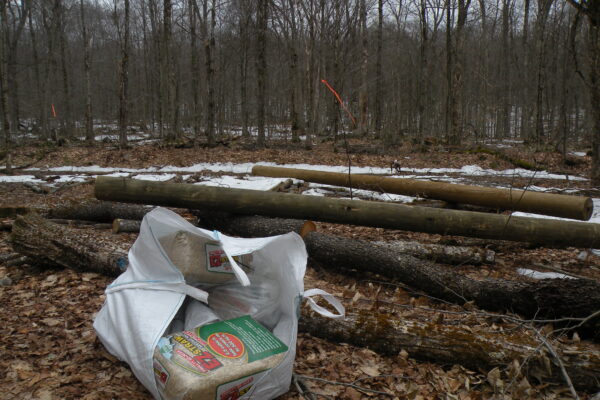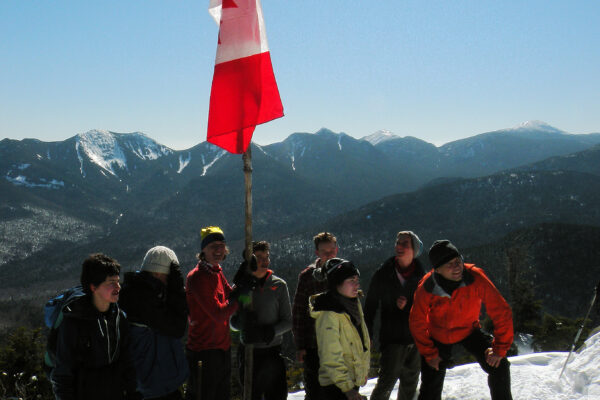AWA’s first order of business in serving on the High Peaks Advisory Group (HPAG) was to ensure that protection of the Wilderness was a paramount and inviolate principle. That was established early in our meetings and it is clearly stated in the HPAG’s Final Report. Now comes the hard part: how to protect and preserve that Wilderness in the face of massive surges in use and the increasing pressures of a changing world.
One of AWA’s early contributions to the process was to stress that these usage surges are highly dynamic and hard to predict. It is not as though we can say “Use is up 15% at the Roaring Brook trailhead, so let’s build a parking lot to accommodate the increase.” The busiest days often come without warning and can be of such a scale that five new parking lots would be completely overwhelmed by early morning. Not only that, but the various problems we see are interdependent in ways that can be very hard to anticipate. Ban parking along Route 73 and suddenly we have an eruption of problems: public safety is compromised as dozens of hikers walk the shoulder of a dangerous highway; social media lights up with negative visitor experiences; lesser trailheads become overwhelmed by diverted hikers; Forest Rangers are tied up writing tickets – and people park illegally anyhow.
The only way to meet a dynamic challenge like this is with a dynamic strategy: adaptive management, driven by science and data. The basic approach is to establish acceptable conditions or thresholds for usage, along with actions to be taken if those thresholds are exceeded; to measure usage and act as prescribed when thresholds are exceeded; to measure the results of the actions; and to change thresholds and actions as more is learned. This iterative improvement in strategies and actions is the engine of adaptive management.
The fundamental mechanism is simple, but implementation is complicated and multi-faceted, and thus requires expert involvement, not anecdotal information. For example, suppose adaptive management is to be applied to a busy trail. There are many factors that affect a trail, the surrounding ecosystem and the wilderness experience of people using it. A professional trail designer can help set a threshold for maximum numbers of hikers on any trail segment in a given time window, so as to avoid excessive erosion and widening. A biologist studying a population of rare songbirds might establish a threshold for numbers of hikers over a longer time span, or at certain times or seasons. There may be a variety of thresholds related to aesthetic factors, such as noise or litter.
Adaptive management is not a new concept: it has been used in many places around the country, including the Adirondack Park. A recommendation to use it can even be found in the existing High Peaks Unit Management Plan (UMP). What is new about adaptive management in the HPAG report is the scope being proposed. Here’s Recommendation Overall-3 from the Final Report:
Overall-3: The State should implement a world-class visitor management system for the High Peaks Wilderness, and ultimately the Park as a whole, using an adaptive management framework. The HPAG recommends adoption of the National Park Service’s Visitor Use Management Framework (VUMF) as the adaptive management tool. This tool was designed by federal land management agencies specifically to manage across a wide range of visitor management issues on federal parklands and forests. Elements of the VUMF are currently being designed and implemented for Forest Preserve projects by both DEC and APA.
The operational role for adaptive visitor and outdoor recreation management must be formalized in a new State bureau or incorporated into an existing State bureau or other State entity. While recreation is a component of DEC’s Lands and Forest Division, a renewed focus on outdoor recreation management must be accompanied by the hiring of trained outdoor recreation professionals familiar with these unique challenges and opportunities. This formal role must encompass and coordinate natural resource management, visitor experience, trail/facility construction, operation and maintenance, and education. The role must also codify enhanced coordination among relevant state agencies, local governments, businesses, and marketing, environmental, and other non-government organizations. World-class adaptive management can only be achieved if it actively involves all stakeholders in a coordinated effort at the data level, process level, and policy level.
This recommendation is a call for adaptive management to apply to every aspect of Park management, not just back country conditions. Consider again our busy trail. Its use is also impacted by accessibility, parking capacity, shuttle services, dispersal strategies, availability of restroom facilities, information kiosks, trail registers and the interests, preparation levels and behaviors of users. All of these things place the understanding of our visitors – their experiences, education, motivations and more – at the forefront of the data we need, and they significantly increase the scope and complexity of adaptive management. That’s why we need experts to develop it.
One of AWA’s primary projects is to not only advocate for adaptive management, but to contribute needed expertise. First, we have our own resources. AWA Board member Kayla White is the Coordinator for the High Peaks Summit Steward Program, which is an unqualified success story and a “best in class” Wilderness management program. AWA Board member Ari Epstein is an expert on data and data management and is building an app that will help with the visitor experience and generate useful data for adaptive management.

Next, AWA has entered into key alliances with professionals who bring with them a wealth of experience. Chad Dawson, Professor Emeritus at State University of New York College of Environmental Science and Forestry, former APA Board member and a nationally recognized authority on wilderness and visitor management, has agreed to assist AWA as a technical advisor. Dawson recently joined Adirondack Wild’s Board of Directors. Adirondack Wild is closely aligned with AWA on wilderness issues, so we have agreed to form an alliance, with Chad Dawson’s expertise at the center, to develop joint recommendations for implementation of the HPAG report. Retiring DEC Forest Ranger Scott Van Laer has also agreed to work with AWA as an advisor. His years of experience working in the High Peaks Wilderness will be invaluable.
Public input will continue to be important. This is especially true with potential policies that remain unsettled and that can be greatly influenced by public advocacy. We will be asking our supporters for input and ideas on several of these issues, starting with our next post, which will consider the pros and cons of the current strategy to disperse visitors from busier trailheads to lesser-used destinations.



